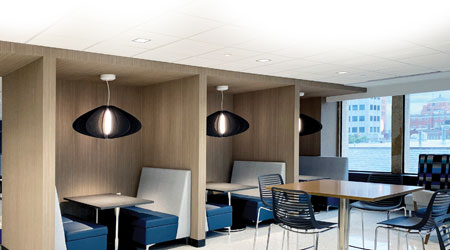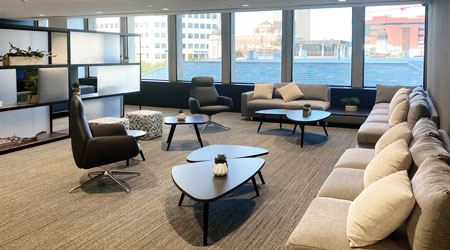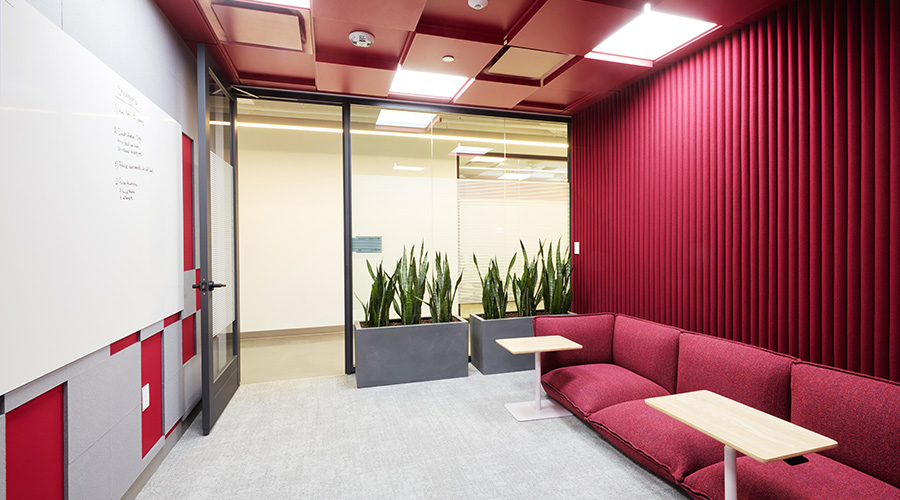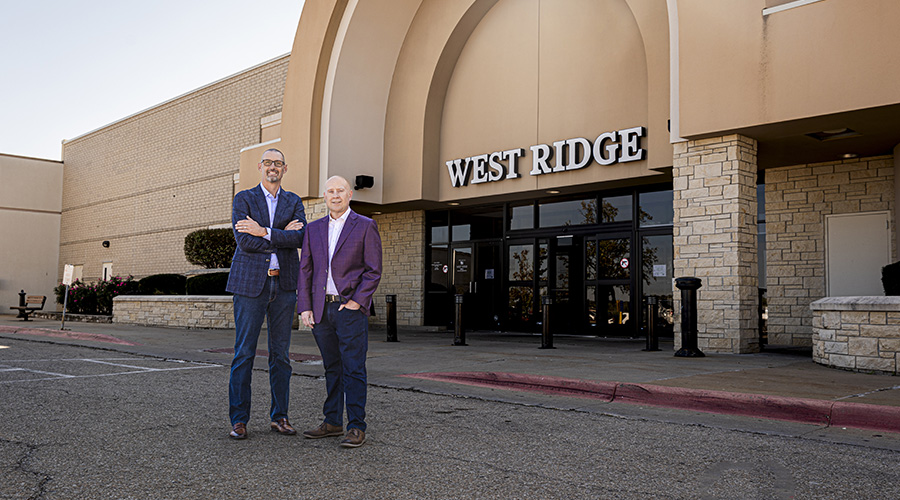 Occupants will be more eager to spend time in the office when there are flexible options for collaboration and heads-downs work.Oculus
Occupants will be more eager to spend time in the office when there are flexible options for collaboration and heads-downs work.Oculus5 Winning Strategies for Your Post-Pandemic Office Playbook
Use these best practices for workplace design strategies to bring occupants back to the office.
Creating a top-tier office space is more than just making sure it looks good. When facility managers start the process of working with a team to design and build out an office, form is important, but function is crucial. A truly great office design must also fit the purpose of the space and inspire employees.
The workplace strategy design process should be driven by your organization’s occupants, as well as the culture. But how have both of those changed as a result of the pandemic? Many companies have started to open their doors back up and are welcoming their staff back to the office or are planning to do so later in 2021.
With some staff being reduced and safety standards around the office heightened, design changes around the office space will need to be made and these changes will affect how you consider office space. While there is no playbook on a standard design process for returning to the office after a pandemic, there are some best practices facility managers can consider.
Depending on the size and procedures of a company, the return of employees to the workplace will vary by organization. With larger companies, it will likely occur in waves. Whichever phase of re-entry to the campus an employee will be included in could be decided by business demands, operational requirements or even the health of the employee.
1. Employee input — When re-entering the workspace, change management is a critical part of the strategy to make returning to work safe for everyone.
For most organizations, a relocation — whether moving to a new office or in this case, coming back to the office — is a difficult and stressful time. To many people, change can be threatening, especially during uncertain times, and communicating with an organization’s staff will help reduce their stress.
Employee input is imperative throughout the change management process. Project initiation and core team meetings should occur on a regular basis. Conducting a workplace satisfaction and expectations survey for all employees can be helpful. This should include feedback on the existing workplace, how satisfied they are with various attributes and the importance they place on these attributes. Pre-COVID and post-COVID questions should be included in this step.
2. Conducting a space analysis
— A space utilization study typically occurs next and includes determining current occupancy levels along with conference room and support and amenity space usage. Interviewing all department and division leaders can assist in identifying future growth, critical adjacencies and the types of functions performed daily, such as people usually working individually or collaborating.
Technology requirements also should be included in this study. Technology has become a central component to the continuity of the workplace. Updating as-built drawings and furniture plans for all occupied spaces usually occurs during this step as well. If a manager’s office is sitting empty due to their ability to work from home, then another employee should be able to use that space. Hoteling or shared desking programs may be limited or made non-existent until the new normal is established.

(Conduct a space utilization study to determine how occupants will best benefit from shared space. This study can also reveal what types of technology occupants will need in their space. Photo: Oculus)
Finally, space standards should be assessed or developed. This can be done by reviewing current furniture contracts and completing an assessment, including price and quality, to determine which to leverage for the long-term plan. It is best to work with furniture vendors to propose furniture standards that allow for a small kit of parts and ease of reconfigurations. From there, propose office, cubicle, hoteling, and conference room size standards, as well as conference room, support, and amenity space ratios based on the input received.
3. Restacking — Many organizations are locked into leases and cannot “right size” without breaking the lease. For these organizations, how can space be used more efficiently? Once space standards have been agreed upon, restacking plans can be developed based on the information obtained from the department leader interviews.
A restack is more than just determining a better way to use space. It involves recreating a workplace to make a more efficient and collaborative space to help an organization achieve its goals. Instead of separating different teams on various floors, restacking a workspace can integrate teams and allow them to work more collaboratively. Before this occurs, test fits of floors can be drafted to determine the feasibility of any construction additions that could be made in order to restack the workspace.
Restacking can help deliver more interaction among co-workers and develop spaces where teammates can come to decisions and problem solve with more efficiency than they ever did before. Restacking can balance the amount of isolated spaces where employees work in private, with collaborative spaces where employees can work together in a variety of team environments. It is about providing options to fit the needs.
In many cases, restacking can take place without any actual physical changes being made to a workplace. Lunch spaces, conference rooms, and other large spaces usually stay in the same places. Changing to a workplace that is more fluid and addresses the future environment and needs of the workforce that incorporates better technology and communication tools, and potentially adds collaborative or amenity spaces, can lead to a new level of employee satisfaction and success for a company.
To restack an office space effectively, just like with change management, it is important to establish a consistent and cohesive team to plan out the process. This cohesive teamwork plays a major role in the success of planning the project. A well-planned strategy is crucial for the restacking effort. Facility managers need to have a firm understanding of what the overall goals of the project are.
It is also important to identify special considerations as early as possible. Differences between floors can be the result of either individual choices or building issues. Some companies do not really have off hours, which can lead to challenges during the process. Phasing may be required during implementation.
Restacking is not always a quick moving process. It usually takes some time to implement fully. However, if expectations are managed and communication is strong among the company’s employees and the team in charge, business can continue unaffected during each step.
4. Move management
— Move management is more than just packing boxes, it is truly a process. Familiarity with all aspects of facility design, implementation, and logistics planning is invaluable to a successful move. Companies can rarely afford to take staff away from normal activities to plan a move properly. Yet, implementing a well-coordinated move is often critical to maintaining productivity and staff morale. It is important to go the extra distance to ensure that employees’ needs are met by providing extensive planning and on-site support during any type of move.
With any move, the proper planning is needed in order to move people, belongings and equipment. It is also imperative to have someone on staff or hired externally that is knowledgeable of the potential pitfalls and how to avoid them. Move management requires an ability to communicate, problem solve, and maintain an attention to detail to successfully coordinate and implement a move.
The move management process should start with interim space and implementation planning. In this step, critical short-term needs that cannot wait for the implementation of the long-term workplace strategy plan are identified. Even during the pandemic, some organizations have continued recruiting and hiring talent. These organizations will need to create a plan that includes new seating for new employees who have not worked in the space and existing employees who may find themselves in new seating arrangements.
It can also be beneficial to develop and deliver pre-move training and workplace guidelines. This can include educating staff on new ways of working, teaming, and office etiquette, as well as sharing any information on new technology that has been adopted. The training materials packages that could be developed may include floor plans with space typologies and workplace guidelines and day in the life examples that can really paint a picture for the employees.
5. Communication — With all the steps, communication is key. Cohesiveness between the facility manager and all departments involved to implement the design will only make the situation easier. All parties involved should participate in frequent project team meetings to discuss progress and upcoming activities. This can include tracking the degrees of change, risk management,and migration to get to the future state of the office. Creating different forms of communications, such as signage, and creating frequently asked questions can also be helpful. Offering electronic communication to occupants on current activities, expectations, a timeline of upcoming activities and messaging on where and to whom to issue questions will keep everyone in the loop and more satisfied with how the process is moving along.
As organizations continue — or begin — to welcome their team members back into the office, they must ensure they are making it a safe and comfortable experience for everyone involved. If there is a negative emotional perception among the occupants that the organization did not do everything in its power to keep them safe, there is the risk of a mass exodus with them leaving for other opportunities. Developing and implementing a proper and thorough change management and move management process can help assure the team that the company has their best interest at heart without the business skipping a beat. It can truly be a win-win situation for everyone involved.
Ali Summerford is the interior design director for Oculus Inc. Oculus delivers architecture, interior design, planning, workplace strategy and move management services.
Related Topics:














